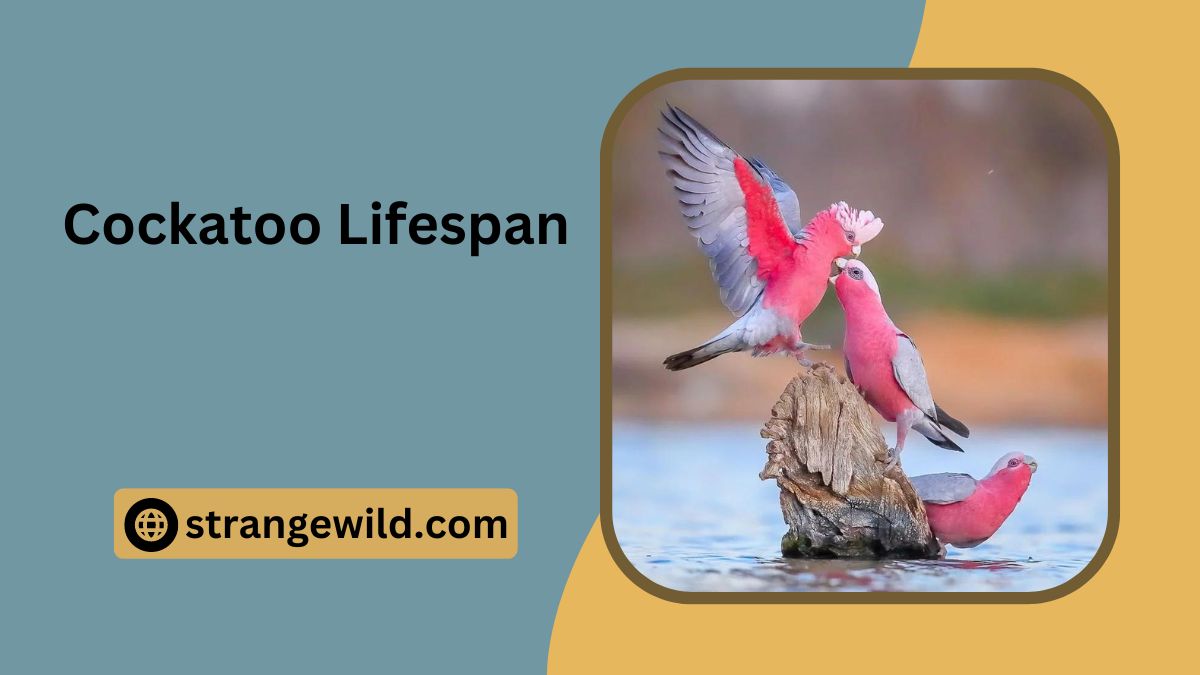Cockatoo Lifespan – In Average
Cockatoo Lifespan? Cockatoos are renowned for their ability to mimic noises, particularly human speech, if there is one thing about them that can be said. However, wait! Cockatoos exhibit other human traits as well. It seems that some species of cockatoo can even live as long as the majority of people!
Cockatoos are a group of parrot species that are frequently spotted in Australia and on a few islands in Oceania. They are members of the family Cacatuidae. With a lifespan of 40 to 70 years, they are known to outlive other pets. Where do Hummingbirds live
The length of each species’ life, though, varies. A cockatoo’s lifespan is also influenced by environmental influences, lifestyle choices, and health issues. These are covered in this article on cockatoo lifespan along with some other helpful information.
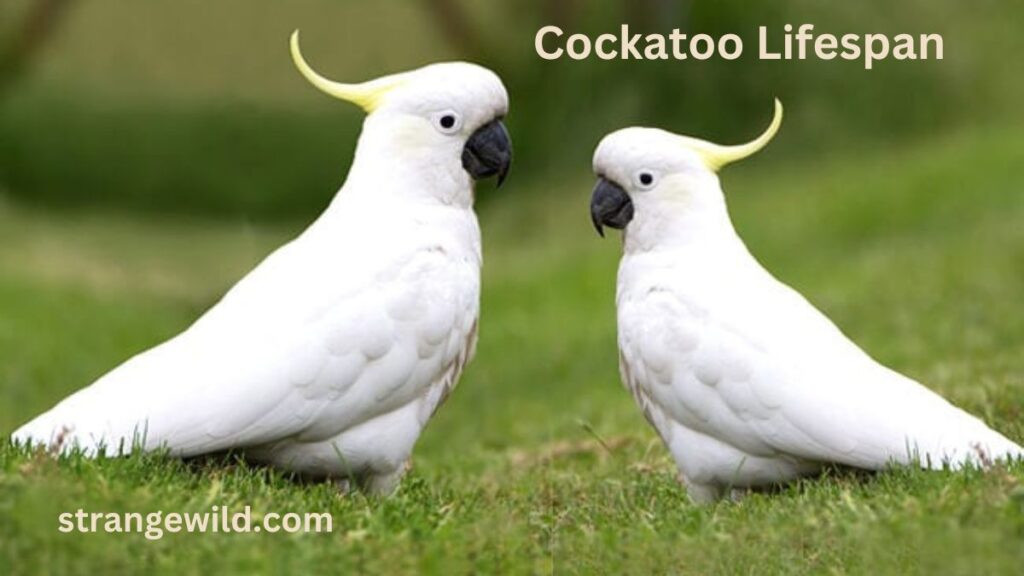
The lifespan of a Cockatoo in Captivity:How Long Can You Keep a Cockatoo as a Pet?
Depending on the species, cockatoos have different life spans. Some cockatoos have a lifespan of barely a few decades, while others are virtually as long-lived as people. Their average lifespan is between 40 and 70 years. Birds Like Parrot
Unexpectedly, cockatoos kept in captivity are found to live longer than their wild counterparts. The majority of domestic cockatoos survive their wild counterparts by over ten years. Of course, if a healthy diet and comfortable living arrangements are offered. The typical lifespans of each species of cockatoo are listed below:
Umbrella Cockatoo (50 – 60 years)
The umbrella cockatoo often called the white cockatoo, is well-known for having a white crest that, when lifted, resembles an “umbrella.” It is well known that this gorgeous white bird may live a very long time in captivity. According to reports, umbrella cockatoos have a lifespan of 50 to 60 years. Types Of Birds
Moluccan Cockatoo (70 – 80 years): Cockatoo Lifespan
The Moluccas, an Indonesian archipelago, are home to the Moluccan cockatoo. It belongs to the largest species of cockatoo yet found. Cockatoo Lifespan
Because of their salmon-pink feathers and crest, they are also known as salmon-crested cockatoos. The Moluccan cockatoos live between 70 and 80 years, which is a fairly long lifespan. Of course, this assumes that they are kept in good condition and cared for while in captivity.
Cockatoo of Goffin (25 – 40 years)
One of the smallest cockatoo species is Goffin’s cockatoo. They have blue eye rims and a brief white crest. The lifespan of a Goffin’s cockatoo can reach 40 years with the right diet and lifestyle.
But it is safe to conclude that the majority of Goffin’s cockatoos survive at least 25 years. Common health problems cause a lot of Goffins kept in captivity to pass away.
Cockatoo Galah (70 – 80 years): Cockatoo Lifespan
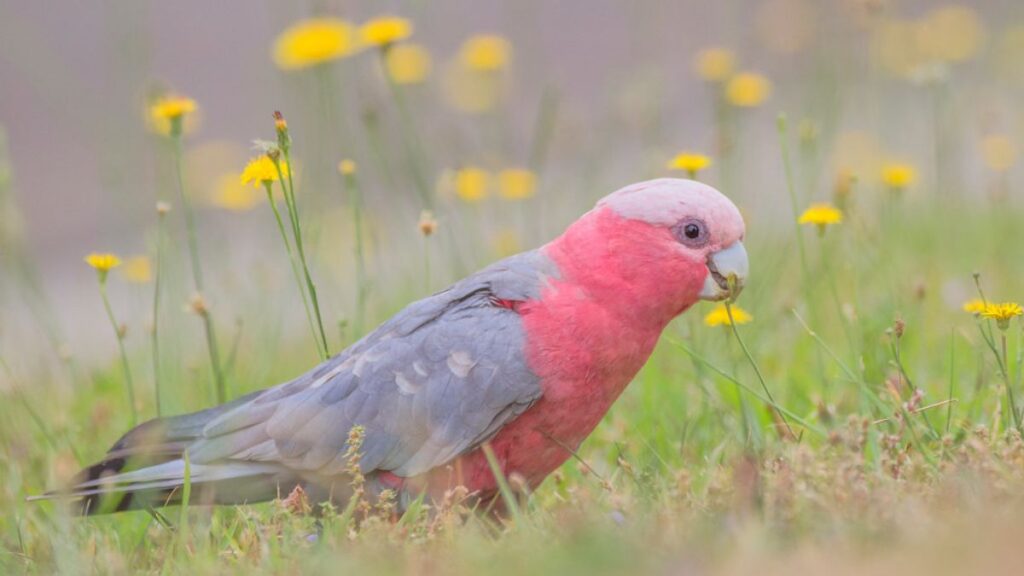
The rose-breasted cockatoo is another well-known name for the galah cockatoo. It displays its silver feathers, which stand out against the bright pink face, abdomen, and breast. When fully grown, this cockatoo can reach a height of 14 inches.
The galah cockatoo can have a long life and might even outlive you with the right diet and care! A galah cockatoo typically lives between 70 and 80 years.
Sulphur-Crested Cockatoo (40 – 60 years)
The sulfur-crested cockatoo, known for its animated and exuberant attitude, can live for 40 to 60 years in captivity. Because of the yellow coloring on their crest, they are known as sulfur-crested cockatoos. Australia, Papua New Guinea, Indonesia, and New Zealand are the original home of this species.
Cockatiel (15 – 25 years): Cockatoo Lifespan
Despite being the smallest member of the cockatoo family, the cockatiel is the most well-liked. The cockatiel has a significantly longer lifespan than other pets, despite its small size. In a well-maintained maintained and cared-for environment, cockatiels can live for up to 15 to 20 years.
If you own a cockatiel, be sure to provide it with the nutrients it needs to grow. A cockatiel’s lifespan is shortened by malnutrition, which is a prevalent medical condition.
Mitchell’s Major Cockatoo (40 – 60 years)
Major Mitchell’s cockatoos are native to inland Australia and have a lifespan of between 40 and 60 years. They bear the name Major Sir Thomas Mitchell in honor of the Australian explorer and surveyor. These cockatoos’ soft white and pinkish feathers, as well as their striking red and yellow crest, are what make them amazing.
Black-Tailed Red-Tailed Cockatoo (45 – 50 years)
The stunning black feathers on red-tailed black cockatoos are emphasized by their plush crest. The red panels and stripes under their tails are the primary reason they are known as red-tailed nuthatches.
However, red-tailed black cockatoos are renowned for being chatty and loud. They live for a very long time—between 45 and 50 years. Make sure you are prepared for a lifetime commitment if you choose to purchase one.
Black Cockatoo of Carnaby (25 – 50 years)
Western Australia is the only place where the Carnaby’s black cockatoo, also known as the short-billed black cockatoo, may be found. It is renowned for both its fidelity to its breeding partner and the contrast between its black body color and the white panels on its tails.
The life expectancy of a Carnaby’s black cockatoo is 25 to 50 years. Unfortunately, this species of cockatoo is considered endangered.
Black Baudin’s Cockatoo (25 – 50 years)
Because they are both members of the Zanda genus, the Baudin’s and Carnaby’s black cockatoos share a striking resemblance in appearance.
Additionally, this kind of cockatoo has white panels on its tail feathers and black feathers. Their life expectancy is between 25 and 50 years.
The length of the bills is the only distinction between Baudin’s and Carnaby’s black cockatoos. While Caranby’s cockatoos have short, wide beaks, Baudin’s cockatoos have long, thin bills.
Cockatoo Lifespan in the Wild: How Long Do Cockatoos Live?
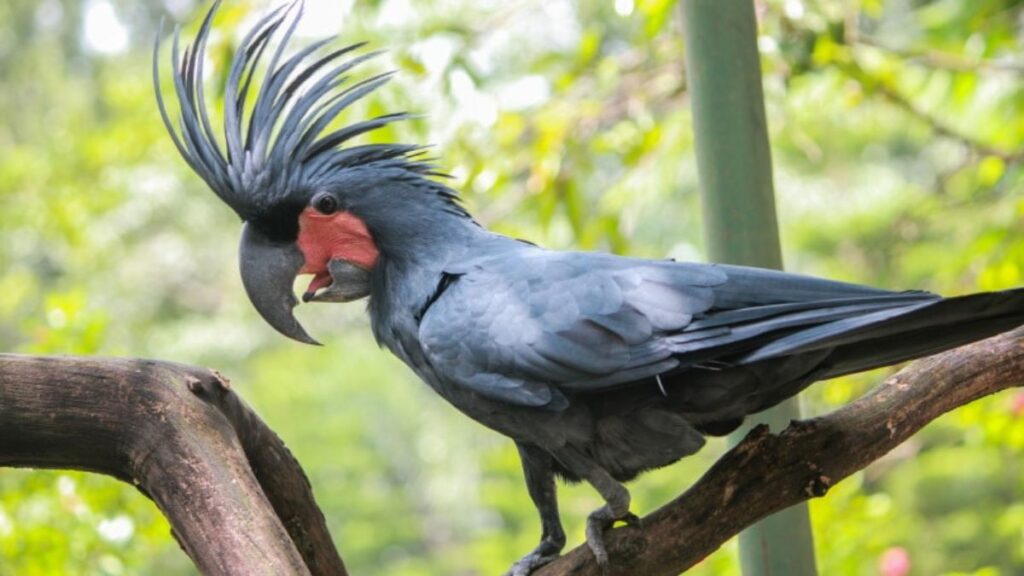
Cockatoos in the wild typically live less time than those kept as pets. Their average lifespan is 20 to 40 years, which is significantly less than the cockatoos kept in captivity. This might be attributed to the dangers and difficulties with survival that they face in the wild.
Wild parrots and cockatoos must expose themselves to predators and other dangers in order to obtain food, shelter, and mates, unlike captive parrots and cockatoos kept as pets.
They are also exposed to extreme weather and natural occurrences. When they suffer from common health problems, wild cockatoos are not also granted the privilege of receiving veterinarian care. As a result, individuals are less likely to survive fatal illnesses and traumas.
Do Cockatoos Live Longer Than Other Birds? – Cockatoo Lifespan vs. Other Birds
In comparison to other popular pet birds, some species of cockatoos live noticeably longer both in the wild and in captivity. They may even stay with you forever if given the right care and attention. Still, have doubts about it? Check it out for yourself!
The lifespans of common pet birds and cockatoos in captivity and in the wild are contrasted in the table below:
| Type of Birds | Life Expectancy (In Captivity) | Life Expectancy (In the Wild) |
| Cockatoos | 40 – 70 years | 20 – 40 years |
| Lovebirds | 10 – 20 | 10 – 15 |
| English Budgie | 7 – 8 | 15 – 21 |
| Parakeets | 6 – 14 | 25 – 30 |
| Parrot | 60 – 70 | 30 – 35 |
| Finches | 5 – 10 | 4 – 7 |
Cockatoos and parrots have the longest lifespans of all the listed pet birds, both in the wild and in captivity. This might be explained by the fact that both of them are members of the Psittaciformes order. The shortest on the list are finches and parakeets.
The fact that the majority of the mentioned birds survive longer in captivity than in the wild is interesting to note. This is most likely a result of the captive birds’ better surroundings and protection from outside predators. Moreover, you can get regular medical attention.
What Cockatoo Is Still Living?
The Guinness Book of World Records recognizes Cookie, a Major Mitchell’s cockatoo, as the oldest bird and the oldest cockatoo kept in captivity. Sadly, Cookie lost her battle with cancer in August 2016 at the age of 82 years and 89 days. Cookie’s actual age is still a mystery.
In 1934, he arrived at the zoo where he was housed. The management began tracking its progress after assuming that his hatch date was 1933. The oldest living cockatoo, according to rumors, is a Duster, an umbrella cockatoo.
According to popular belief, Duster was born in 1925. If this is the case, he would already be 96 this year if still alive. The last time we heard from Duster was when he appeared in a Florida Parrot Rescue Facebook video in 2016 at the age of 92.
The Factors That Determine a Cockatoo’s Lifespan
Even while cockatoos have longer life spans, there is no assurance that your bird will live for many years. The lifespan of your cockatoo is also influenced by other variables. The following elements affect a cockatoo’s lifespan, both in the wild and in captivity:
Environment
The cockatoos’ native habitat has been steadily lost as a result of illegal logging, deforestation, and urbanization. Wild cockatoos are more susceptible to predators and unfavorable weather as a result of changes in their natural habitat and environmental landscape. Extreme weather events and other natural phenomena can also affect how long and how often wild cockatoos survive.
Without trees and forests to provide refuge, cockatoos are more vulnerable to threats and dangers, which shortens their life spans. The majority of cockatoos kept in captivity, however, suffer when they are exposed to pollution and dangerous household chemicals. Aerosols, fumes, and other chemical substances that are easily disseminated in the air might harm the fragile lungs of cockatoos. Cockatoos are prone to poisoning, so be sure to keep an eye on what your bird eats!
Cockatoos get stressed out by excessive noise. Therefore, if you own cockatoos, make sure they have a favorable environment that is free from stressors, hazardous chemicals, and pollution. Additionally, you should teach your dog and cat to socialize with your cockatoo so that it doesn’t end up as prey.
Predators
In the wild, cockatoos are subject to the dangers posed by their innate predators. In the wild, these cute birds are frequently pursued by large wild feline species, owls, falcons, eagles, and snakes.
The number and life spans of cockatoos in the wild have decreased as a result of illegal poaching and hunting. Some species of black cockatoo are currently protected by law and are thought to be in danger of extinction.
Genetics
In the same way that traits can be passed on, birds can also inherit health problems. Some cockatoo species experience common illnesses that shorten their lives. Infections, cancers, genetic problems, and organ failures are only a few of these illnesses.
Because their owners will undoubtedly take them to veterinary clinics, cockatoos kept in captivity have a greater survival rate while suffering from the aforementioned diseases. When they become ill, wild cockatoos, on the other hand, must rely only on their instincts and the course of nature.
Workout and Diet
Flying and unrestricted movement are expected of birds. A cockatoo should occasionally be let out of its cage to engage in physical activity. It has been shown that cockatoos who lead active lives are less stressed. The cockatoo’s body muscles are stimulated by playing and performing activities.
Additionally, they support the body’s normal metabolic processes, lowering the risk of obesity. The lifetime of cockatoos is substantially impacted by diet as well. A nutritious diet may promote a long, healthy life. In the wild, cockatoos have access to a diverse range of food, including fruits, nuts, seeds, and roots. They receive the many vitamins and minerals that their body requires for growth from this varied diet.
Unfortunately, when food and resources are few in the outdoors, wild cockatoos may become vulnerable to starvation. Perhaps fewer people die from starvation and malnutrition than from diseases, predators, or severe weather.
However, they continue to make a sizable contribution to the shortened lifespans of wild cockatoos. Owners should be careful about the food they give their pet cockatoo in the meantime. Additionally, captive birds require nutritious and varied meals.
In addition to high-quality avian seeds and pellets, owners should think about giving their cockatoos fruits, berries, and vegetables. Wild cockatoos die from malnutrition, although caged cockatoos frequently gain weight. Overeating combined with inactivity might result in unhealthy weight gain. You should keep an eye on how much food your cockatoo consumes and make sure it gets regular exercise.
Inbreeding
Inbreeding occurs when two closely related cockatoos are mated. When cockatoos from the same family mate, their children are far more likely to be born with congenital diseases.
The decrease in the gene pool is the cause of the anomaly in inbreeding. When this occurs, diseases and undesirable features are more likely to manifest and develop, which can decrease a person’s lifespan.
What Causes the Most Deaths in Cockatoos?
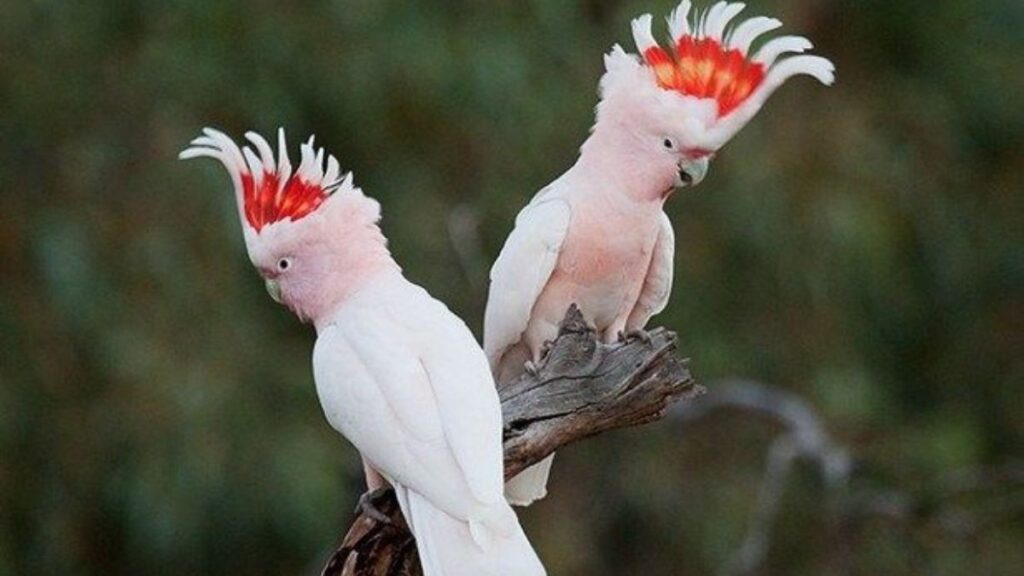
The cycle of life and death cannot be stopped, but at least avoidable tragic situations can be avoided. You might be shocked to learn how insignificant pet cockatoo deaths can be if you’re a new owner of one. Food poisoning is the most frequent reason for cockatoo deaths in captivity. Some of the dangerous foods for cockatoos are alcohol, caffeine, chocolate, avocado, onions, and garlic.
Any of the foods I listed could cause symptoms in cockatoos, including diarrhea, vomiting, nausea, tremors, and seizures. If things go bad enough, the cockatoo might die suddenly. Following the list of the most frequent causes of cockatoo death is intoxication.
A bird’s health can be harmed by toxic chemicals, heavy metals, and household pollutants. If your cockatoo drank contaminated water or breathed in-home toxins like spray and paint, it might become frail and eventually pass away. Predation, however, is the main reason why wild cockatoos perish.
In the wild, eagles, owls, snakes, and big predators are always after them. They also pass away too soon as a result of illegal hunting and poaching. Another frequent cause of death for wild cockatoos is egg binding. When the egg becomes lodged in the female bird’s reproductive system, this occurs. Unfortunately, because of the need for veterinary care, most wild cockatoos with egg binding pass away.
Cockatoos’ Common Health Issues: Cockatoo Lifespan
Although cockatoos often live long lives, they are not immune to health problems. If neglected, some of these widespread diseases can be fatal.
The following are some frequent ailments that cockatoos may experience:
PBFD, or Psittacine Beak and Feather Disease: This extremely contagious illness affects cockatoo feathers and beaks. Growing dead or deformed feathers and beaks are symptoms of PBFD. Additionally, it weakens the bird’s immune system, leaving it more vulnerable to other illnesses. Unfortunately, there is currently no cure for this disease. Within six to twelve months, subsequent infections kill the majority of affected birds.
Bumblefoot: Also known as pododermatitis, this condition causes the cockatoo’s feet to become lame and swollen. Lesions can also be seen often. Diet and environment are the main contributors to this syndrome. Bumblefoot can be brought on by nutrient deficiencies in things like vitamin A, biotin, and calcium. Your cockatoo’s feet could become infected by bacteria that thrive in an unclean cage and perch.
Feather Picking and Self-Mutilation: Due to this behavioral abnormality, cockatoos may mutilate their own flesh or pick at their own feathers. This ailment, according to experts, is primarily brought on by stress, boredom, and dissatisfaction. You should seek quick medical advice if you discover symptoms of plucking and mutilation in your cockatoo. In their advanced stages, feather plucking and self-mutilation are particularly challenging to treat.
Obesity: Due to the nutritional value of the food they consume, pet cockatoos are at significant risk of getting overweight. A cockatoo that is obese may experience joint discomfort, respiratory issues, diabetes, heart disease, and fatty liver disease. Providing a variety of food for your cockatoo is the greatest method to keep it from being overweight.
You should include vegetables and fruits in your bird’s diet in addition to seeds.
Additionally, regular exercise can lower the chance of developing obesity. If you are aware of the common health problems that your cockatoo could experience, you are one step closer to death. Never forget that prevention is always preferable to cure.
Four Tested Methods to Make Your Cockatoo Live Longer
The only thing we as pet owners want for our animals is for them to have long and happy lives. How can we help our cockatoos live long lives, though, given all the dangers and diseases that exist? No more worries!
The following four tried-and-true methods can help your cockatoo enjoy a long and healthy life:
Offer a wholesome diet: Cockatoo Lifespan
Like people, the health of cockatoos greatly depends on the food they consume. In order to provide the body with enough vitamins and minerals, cockatoos kept in captivity should also be fed vegetables and fruits in addition to seeds.
A balanced diet will support the cockatoo’s overall development. Healthy food also aids in boosting your bird’s resistance to common cockatoo illnesses and infections.
Promoting physical activity: Cockatoo Lifespan
You should occasionally let your cockatoo play outside of its cage. Cockatoos kept in captivity should be able to fly and frequently roam the house, much like the wild ones. Your cockatoo will be less likely to gain weight if it is active.
Cockatoos experience less tension and boredom while they are playing and completing tasks. This aids in preventing behavioral problems in your pet, such as feather plucking and self-mutilation.
Keep their enclosure roomy and tidy
The cockatoo should have ample room in the cage to fly and move about without restriction. To avoid foot lesions or bumblefoot, the perch of the cage must be the proper size.
To stop bacteria from growing in the food scraps and fecal waste, you should also frequently clean the cage. Consider getting a cage with a detachable fecal compartment to make sanitation and cleaning easier.
Keep potentially dangerous household items away from your cockatoo
Poisonous substances for cockatoos, such as chemicals, heavy metals, and human food, should be kept out of the cage where your pet is housed. When your bird is not in its cage, you should keep a close eye on it as well. When eaten, a single metallic ball poses a threat to life.
Additionally, you should watch out that it doesn’t breathe in dangerous fumes like aerosols and paint. The bird’s respiratory system may be harmed by these gaseous substances.
Frequently Asked Questions: Cockatoo Lifespan

Cockatoos: Can They Live to 100?
Cockatoos can live up to 100 years with the right upkeep and care, though this is uncommon. The unofficial oldest bird and cockatoo in the world is said to be Cocky Bennett, a male sulfur-crested cockatoo. He was 120 years old when he passed away in 1916. He was born in 1796. Nevertheless, most cockatoos live between 40 and 70 years on average.
What Is the Lifespan of an Australian Cockatoo?
Galah, sulfur-crested, Caranaby’s, red-tailed, Baudin’s, Major Mitchell’s, and cockatiels are native to Australia. The average lifespan of these cockatoo species is 25 to 60 years.
How to Determine the Age in Human Years of a Cockatoo?
Following these steps will allow you to quickly determine your cockatoo’s age: First, divide the average lifespan of a person (72.81) by that of a cockatoo (55). The ratio is going to be 1.323. Accordingly, a cockatoo’s year corresponds to 1.323 years in a human’s age.
You only need to multiply your cockatoo’s age by the quotient we have if it is 25 years old. So, in human years, your cockatoo is 33.075 years old.
How to Determine Your Cockatoo’s Age
Aging in cockatiels differs from aging in humans. As they age, the majority of birds do not even exhibit indications of aging.
However, there are other methods besides counting the number of grey feathers and wrinkles that can be used to determine a cockatoo’s age.
When female cockatoos reach sexual maturity, their eyes become lighter in hue. Typically, this occurs when a child is two years old. Old age also indicates worn-out feet and beaks. Typically, juveniles have beaks and feet that are smooth.
Conclusion: Cockatoo Lifespan
Cockatoos are unquestionably one of your greatest options if you’re searching for a lifelong commitment. They could be your constant companions. They are not only entertaining and affectionate, but they require less upkeep than other pets do.
However, if you intend to own one, you should be prepared to meet all of their demands, just like you would with any other animal. When it comes to affection and attention, cockatoos are quite picky. They may turn to self-mutilation and feather plucking if they are anxious and frustrated.

